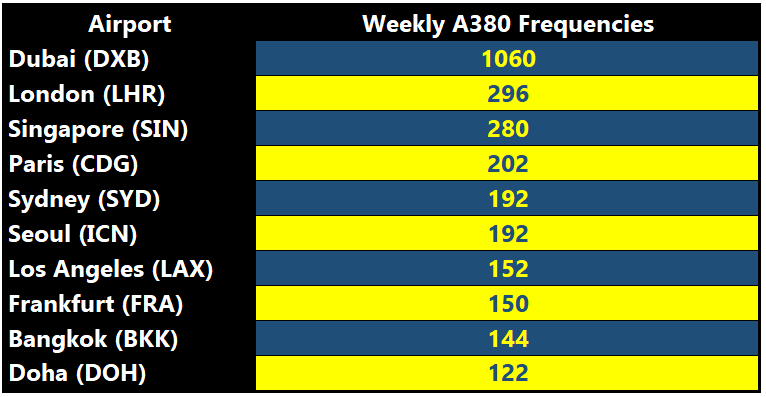Summary:
- Airbus has confirmed A380 production will end in 2021;
- Some major airports ignored the aircraft, it while others went out of their way to accommodate it;
- The biggest impact will be in Dubai but other airports must rethink their infrastructure strategy.
But A380s will remain part of the global aviation network for a long time yet until the latest aircraft are retired, unless its costs become totally unsustainable, which could be the case if fuel prices were to rise dramatically of course.
Regardless of that end date, airports need to start planning now for life after the A380, a commercial passenger airliner that is unique in the handling challenges it poses. Those airports that have been considering adjusting or adding to their infrastructure in order to attract operators of the A380 will need to reappraise those plans.
The leading airports for the A380, as measured by take offs and landings, are primary hub airports as the aircraft was designed to enable hub transfers while minimising frequencies. Top of the list, unsurprisingly, is Dubai International, the world's busiest airport for international traffic, with a total of 1,060 A380 frequencies (arrivals and departures) each week.
TABLE - The ten largest airports for A380 operations all currently have more than 100 weekly frequencies from the type Source: CAPA - Centre for Aviation and OAG
Source: CAPA - Centre for Aviation and OAG
Dubai International Airport is built around the A380; after all there are 109 in service with Emirates and another 14 on order according to the CAPA - Centre for Aviation Fleet Database, with an average age of 5.2 years. Emirates is now looking smaller (but not that much smaller), with twin-engined much more fuel efficient aircraft with a similar range.
Emirates' Dubai International hub initially it spent USD120 million to upgrade both of its terminals and airport infrastructure, then USD3.5 billion into a new Concourse A, which opened in Jan-2013, exclusively for handling the airline's A380s. Purpose-built gates were later added specifically to enable passengers to get on the aircraft's upper cabin directly from the gate hold rooms. Concourse D was also configured with the A380 in mind.
Dubai World Central was also envisioned with the same objectives, in fact even more ambitious ones. Even the first phase included two satellite buildings which would collectively be able to receive 100 A380 aircraft at any one time and the runway was A380-capable from the start. Its construction has been scaled back however, and while it is now expected to completed by 2030, five years later than originally anticipated, with an annual capacity of 130 million rising to 260 million passengers.
After Dubai International, there is a huge gap to #2 in the list, London Heathrow, with 296 weekly frequencies. Heathrow is severely capacity constrained though it still manages to squeeze more passengers in each month (+2.1% in Jan-2019). Those constraints made it perfect for the frequency-reducing A380 and terminal adjustments were made with it in mind.
The A380s demise must influence not only the thinking behind any future 'Terminal 6' but also the forthcoming judicial review into the third runway (as the number of future aircraft movements and subsequent noise/emissions must be affected accordingly. LHR R3 is still not a "done deal" and the lack of A380s in the future could yet have an ironically significant bearing.
Pretty much the same applies to the other airports in the Top 10 list. The interesting one is Los Angeles International, which is the only North American airport on the list (and there are only five of them in the Top 50). The A380 is intrinsically European of course and was not looked upon favourably by the US industry in general when it first went into service in 2007.
Many airports there cut off their nose to spite their face by not catering for it in terms of apron space, pavement weight, fuelling and catering services and embarkation/disembarkation procedures. But Los Angeles International is a little different in that it has become the major US gateway to and from Asia Pacific, more so than San Francisco and Seattle-Tacoma, in addition to a comprehensive European, West Asian and Middle Eastern network that avoids hubbing.
Many of those routes require large wide body jets and half of the 18 gates at the Tom Bradley International Terminal (TBIT) were built to handle the A380 and the B747-8.
Los Angeles World Airports is a forward-looking organisation in several ways. Apart from the TBIT provision for these very large aircraft, it is currently building a people mover and a consolidated car rental terminal under a P3 (public-private) mechanism and it will soon be connected by an additional Metro line and station. What it will probably be weighing up now is whether it should make any further provision for an aircraft that is flying on borrowed time.